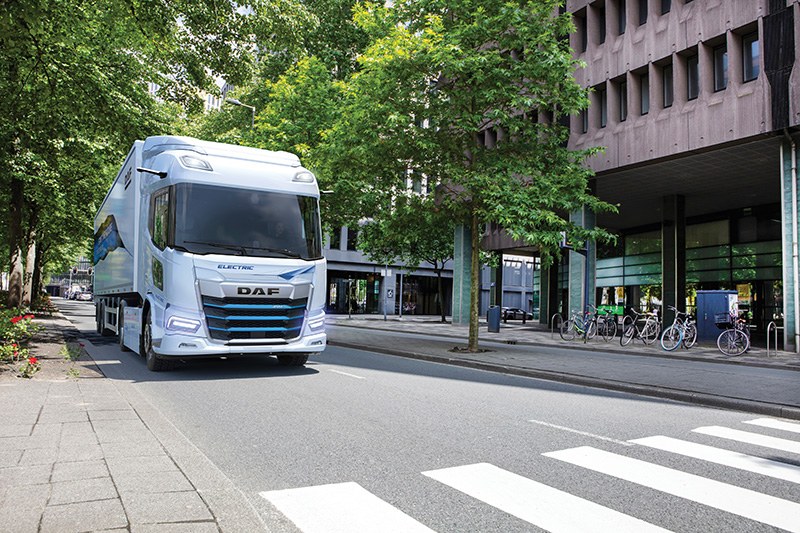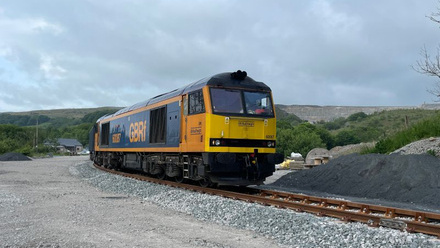The ultimate destination - decarbonising heavy goods vehicles
How is the UK driving towards more sustainable heavy goods vehicles? Two IOM3 members from Innovate UK explain more.

Almost everything that enters our homes gets transported using a heavy goods vehicle (HGV). Road transport is a crucial and competitive sector that is vital to the UK economy. It encompasses a variety of services, often overlooked, yet operating within strict delivery schedules.
According to the UK Government, transport as a whole is responsible for about a third of the UK’s annual carbon emissions, and HGVs contribute about one-fifth of this. The UK’s net-zero 2050 target requires changes to how all sectors operate and work on the largest HGVs is already underway.
The largest vehicles have a total weight of 44t and a payload of ~25t. In 2021, the UK Government stated that it will phase out the sale of new, non-zero emission HGVs – 2035 for smaller vehicles that are ≤26t, or 2040 for larger vehicles, which are generally articulated.
Beyond this point, it will not be possible to buy a new HGV unless it is zero-emission.
All signs are pointing towards a significant shift towards zero-tailpipe emission HGVs over the coming years. Some may focus on electro-fuels (renewable synthetic hydrocarbons) or biofuels in the interim, but there is broad consensus that zero-tailpipe emission vehicles are the ultimate destination. This serves a joint purpose – significantly lower whole-life carbon dioxide equivalent emissions, as confirmed by multiple lifecycle assessments, and reduced impact on local air quality when compared with alternatives.
Innovate UK is supporting UK businesses to play an important role in developing and testing zero-emission technologies at scale, connecting industry and enabling large on-road demonstrations.
Driving forward
Many leading vehicle manufacturers have already publicised their zero-emission vehicles. The fundamental technology is tried and tested, and most have vehicles out with customers.
Decarbonising heavy duty vehicles is a long process due to the lifetime and slow turnover rate. Several approaches are being considered, some are nearer-term propositions, and some are further down the road. New infrastructure is in varying stages of maturity, but there is a significant amount that can be done now using current technology.
Biofuelling
Biofuels usage is increasing for HGVs. However, engineering consultants Ricardo produced lifecycle analysis on behalf of the UK Department for Transport in 2021 that projected modest carbon dioxide emissions savings from biofuels use. They project significantly greater savings through the use of zero-tailpipe emission technologies.
Furthermore, bio-derived fuels are in higher demand in more difficult-to-decarbonise sectors, which may pay a premium beyond what is affordable for road transport due to a lack of feedstock or alternatives.
Volt and bolt
While drop-in technologies such as biofuels are important, they are not the only way to decarbonise. Zero-tailpipe technologies exist today, with most manufacturers at small-scale production of battery-electric HGVs.
These vehicles typically contain batteries that have a capacity of over 500kWh – approximately eight times larger than a passenger electric car. In theory, it should be possible to recharge these batteries at eight times the power of those electric cars, to achieve an equivalent charging rate and duration without putting any additional stress on the battery packs.
The megawatt charging system (MCS) is starting to be deployed, offering power output of several megawatts. This is not straightforward as the local grid will need to deliver the power equivalent of a small town to individual vehicles. Nevertheless, charging at these rates is possible without additional stress on batteries, and will enable significant increases to vehicle operational ranges during driver breaks or loading/unloading, where the infrastructure can support it.
The current range of battery-electric trucks is below diesel vehicles, but they are advancing rapidly and, in the future, the majority of HGVs will be battery electric. They are currently benefiting from the engineering experience of the passenger car segment, they offer the lowest lifecycle carbon emissions of any HGV technology, and have a smoother drive free from harmful tailpipe emissions.
Initial testing of battery-electric HGVs has been positive. The Battery Electric Truck Trial project, launched between April 2022 and September 2023, saw 20 x 19t DAF electric trucks operating with the support of funding from the Department for Transport. The trucks combined almost covered 300,000km and demonstrated how battery-electric truck operation works in the real world.
There are a decent proportion of operations that can be completed using current battery-electric HGVs, but plenty of HGVs operate around the clock and spend little time stationary, leaving limited opportunities to recharge. Some are turning to hydrogen to improve the operational capability.
Hydrogen
The majority of hydrogen fuel-cell vehicles are at the prototype stage and costs reflect this. The technology shares many similarities with battery-electric HGVs. A much smaller battery is used for motive power, but continually recharged using a hydrogen fuel cell.
Tanks of gaseous hydrogen store between 50 and 90kg of hydrogen at up to 700bar, and refuelling would take two or three times longer than a diesel HGV but with twice the range of a battery-only HGV.
While the technology produces no tailpipe emissions, like other zero-emission technologies, it presents some engineering challenges. For example, it requires significant air handling equipment for heat rejection.
Hydrogen must also be produced renewably to ensure low-lifetime carbon emissions. It is expensive to transport as a gas due to its low-volumetric energy density and has a propensity to leak. Generally, it makes sense to produce hydrogen via electrolysis at the location of use, but if you can get electricity there, then it may make more sense to store the electricity in batteries instead.
Some companies are experimenting with cryogenic liquid hydrogen, in particular Mercedes-Benz, part of Daimler group. This has some advantages, including a longer range due to improved energy density, but a further thermodynamic and cost penalty due to the liquefaction process.
Hydrogen combustion, where the hydrogen is burnt in a relatively conventional internal combustion engine (ICE), is also being considered. But many believe this approach will have lower efficiency than a fuel cell, and this has a large impact on the cost of operating these vehicles. It seems unlikely to gather significant traction for on-road operations, even if the purchase price of the vehicles is lower. It may be more applicable for off-highway applications, or for upgrading otherwise end-of-life special purpose vehicles.
For hydrogen, the overall inefficiency of the chemical processes involved adds to the cost, and infrastructure is expensive and complex. These properties are largely inherent.
Nevertheless, this technology can offer lower lifecycle emissions than diesel technology, and the propulsion of the vehicles does not negatively impact local air quality. Technical progress in recent years has included the move to higher pressure for hydrogen storage, increasing the capacity of energy stored on board, as well as efforts to standardise the refuelling equipment.
In conclusion, this means hydrogen fuel-cell vehicles are likely to be used only in limited niche operations for which battery HGVs are unsuitable, but a zero-tailpipe solution is required.
Embodied emissions
The most visible efforts to decarbonise road transport focus on the fuel and enable the use of renewable energy alongside a rapidly decarbonising electricity grid. While this switch reduces the overall lifetime emissions and emissions during use, those associated with vehicle production – i.e. the embodied emissions – are critical in determining the carbon footprint.
Production emissions for battery-electric articulated lorries are currently around 140% higher than diesel, primarily due to the batteries. This is clearly a challenge, but one that is being actively worked on as an engineering challenge and opportunity.
According to the Department for Transport’s 2022 report, Lifecycle analysis of UK road vehicles, around 65% of the total lifetime emissions are at the tailpipe for diesel passenger cars. The move to zero-tailpipe emission alternatives therefore has a huge impact on total emissions, but there remains carbon embedded through manufacture. It is similar with other vehicle types, so the supply chain will be the next battleground in reaching net-zero for transport.
The batteries also contribute to a significant increase in vehicle weight compared to ICE vehicles. Lightweighting is needed to compensate for the added weight, which impacts on materials selection in the design. There may be increased use of lighter-weight aluminium or fibre-reinforced composites, but these typically have higher embodied emissions than steel (per unit mass), for example, which is one of the major materials currently used in road vehicles.
The greatest contributor to the embodied emissions of the vehicles come from materials production. Most of the vehicle mass is produced by the Foundation Industries (FIs). The FIs in the UK face common challenges related to energy intensity, scale and history of the processes used to produce these vital materials.
However, adopting new processes requires large capital investment to deliver products at scale. To unlock this investment and accelerate adoption, the demand for more sustainable and innovative materials needs to be clearly demonstrated. Agreements between automotive original equipment manufacturers and material producers have recognised this need.
Volvo Trucks has delivered heavy-duty electric trucks with fossil-free steel from Swedish steel manufacturer SSAB, while Hydro Extrusions has agreed to supply low-carbon aluminium extrusions to UK start-up automotive company Watt Electric Vehicles.
Deeper collaboration along the supply chain is needed to implement a more circular economy and drive down more difficult-to-abate emissions, ultimately to realise the transformative change needed to achieve industry and government net-zero commitments.
UK Research and Innovation’s Transforming Foundation Industries Challenge, delivered by Innovate UK, EPSRC and ESRC, has been helping these industries collaborate and innovate to grow in an environmentally sustainable way.
Through the Challenge, Innovate UK is working with Ricardo to understand the future material demands on the FIs from the automotive sector, with a view to providing support to overcome the innovation challenges and fostering more collaboration through the supply chain.
Overall, challenges remain in how to deploy these low-emission vehicles at scale (embodied and at tailpipe) and integrate them within the logistics system. This means redefining business models, and the rapid and cost-effective deployment of infrastructure. Reassuringly, there is clear direction from policymakers, and Innovate UK is helping businesses to engage with this transition by enabling mass roll-out of these decarbonised HGVs years earlier than would otherwise be possible (see box-out below).
The UK’s zero-emission heavy goods vehicle and infrastructure demonstrators
Recognising the journey to decarbonise the heavy goods vehicle (HGV) sector, the UK’s independent Climate Change Committee has recommended that the UK undertake large-scale commercial demonstrations of zero-tailpipe emission HGVs. The aim being to collect data on costs, system performance and suitability to different HGV operations.
While the zero-emission HGV technologies discussed have challenges, they work well at a fundamental level, and show a clear and scalable path towards decarbonising this sector. All produce significantly lower emissions over their lifetime than the diesel that is used today, and this is consistent with the COP28 call to 'transition away from fossil fuels'. The demonstrations are important to understand how to scale up these technologies, and where further attention is needed.
Preparatory work was conducted by government-funded feasibility studies, before Innovate UK launched a larger Open Access fund for industry-led, on-road demonstrations.
In October 2023, the UK’s £200mln Zero Emission HGV and Infrastructure Demonstrator programme was announced. This is delivered through a partnership between Innovate UK, part of UK Research and Innovation, and the UK’s Department for Transport.
Innovate UK supports business-led innovation, and works closely with industry to understand the needs, opportunities and timescales required to deliver high impact. Innovate UK is delivering activities and funding to enable rapid deployment of large-scale, real-world demonstrations. This supports the private sector to innovate in line with policy objectives. This programme will help accelerate the UK’s preparation towards phasing out the sale of new, non-zero emission HGVs.
The £200mln is part funding industry to deploy around 370 zero-tailpipe emission HGVs and all the infrastructure they require. Some of this will be at vehicle depots, while some will be more visible and is likely to include some HGV-specific infrastructure at motorway service areas or truck stops.
There will be a range of vehicles from different manufacturers – the majority will be battery-electric HGVs. Much of the government-funded infrastructure will be open access, so commercial vehicle drivers who are not involved can access it.
GRIDSERVE already provides passenger car charging infrastructure at motorway service areas and is gearing up to do the same for HGVs as part of their Electric Freightway project. UK charger manufacturer Voltempo is looking to build a range of high-power truck charging sites, while project HyHAUL will deploy 30 hydrogen fuel-cell HGVs to hauliers operating along the M4 corridor. bp is exploring battery-electric and hydrogen fuel-cell vehicles and deploying both types of infrastructure.
One key element is the high level of engagement freight operators have in this programme. The industry is low margin and highly competitive. Participation will include Eddie Stobart, Amazon, Royal Mail, Wincanton and Maritime Transport. It will see Nissan Manufacturing UK working to decarbonise its supply chain, and companies such as Welch’s Transport or FSEW working to enhance their established low-carbon logistics propositions.
While the vehicles the freight operators use look familiar, this hides a huge range of operating models and customer requirements. The industry is extremely dynamic and time sensitive. Some operators will have set routes operating regularly, others will send a driver out and adjust routing on the fly throughout the day to respond to customers.
This transition may mean competing companies have to work together in new ways, such as installing shared infrastructure. Hauliers may also require customers to install infrastructure to conduct their operations. From a business perspective, there is a lot to consider.
Innovate UK has again engaged engineering consultants Ricardo to work alongside the funded projects so that government and industry understand what works and where the difficulties are.
Through this transition, it will be critical for the businesses involved to ensure that they meet customer demands. Freight hauliers need reliable vehicles, infrastructure needs to work effectively and be available when necessary, the energy system needs to evolve, and
the supply chain needs to get cleaner. There is lots to do to reach critical mass and make the transition deliver value – this is likely the largest change the industry has ever encountered.







